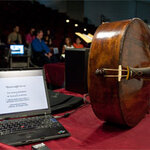Anthropology
By studying the Y chromosome from human dental remains from the Canary Islands, researchers have determined the origin and evolution of paternal lineages from the pre-Hispanic era to the present day. To date, only mitochondrial DNA had been studied, which merely reflects the evolution of maternal lineages, but a team of Spanish and Portuguese researchers carried out molecular genetic analysis of the Y chromosome (transmitted only by males) of the aboriginal population of the Canary Islands to determine their origin and the extent to which they have survived in the current population.
The…

The enormous difference between high and low tide in Haida Gwaii – up to twenty three vertical feet – means that twice a day, vast swathes of shellfish are unveiled, free for the taking.
An ancient Haida saying is still often heard today, “When the tide is out, the table is set.”
Archaeological evidence shows that by about five thousand years ago, gathering shellfish replaced hunting and fishing as their primary food source. The shellfish meat was skewered on sticks, smoked and stored for use in winter or for travel.

Genealogy is the study of ones family history and background. I have been doing such a study in my spare time. What I found was in a word shocking, affirming, and surprising. I knew from oral history passed down by my elders including a 98 year old Aunt, now passed away, that our family originated in colonial Virginia. What I did not know was much about what happened between our earliest African ancestors arriving, and my great great grandfather.
What I knew was told to me in the form of a oral history. The oral history of the Farmer family as passed down…

Data concerning the parties with 30 young beauties (paid 1450$ each for their time, plus various benefits and gifts) held by the Italian Premier Silvio Berlusconi in his residences in Rome and Sardinia, between September 2008 and January 2009, have been disclosed the other day by the provider of the girls, Giancarlo Tarantini. Tarantini is under investigation for several charges (including, it seems, drug abuse and distribution at his own parties), and he is spilling his guts. We thus learn from him that many of the involved girls allegedly spent the nights at the Premier's house…

For most of the last century archaeologists, anthropologists, linguists and even geneticists have argued about who the ancestors of Europeans living today were.
People lived in Europe before and after the last big ice age and managed to survive by hunting and gathering and farming spread into Europe from the Near East over the last 9,000 years, which boosted the amount of food that could be produced by as much as 100-fold. But the extent to which modern Europeans are descended from either of those two groups has eluded scientists.
Not now, according to a team from Mainz University in…

Do you long to hear the dulcet sounds of the salpinx, barbiton, aulos or the syrinx? Of course not, because no one has heard them in centuries. Most people have never even heard of them.
But you will soon have the chance to experience musical instruments familiar to ancient civilizations but long since forgotten.
Ancient instruments probably got lost because they were too difficult to build or too difficult to play. The ASTRA (Ancient instruments Sound/Timbre Reconstruction Application) team is tasked with bringing them back to life and already have…

Want to drive the politically correct segment of academia into a tailspin? Tell them there's a group of people hurting animals and watch the outrage. Then tell them they are religious and watch it grow. But then tell them they are a South American religion and it's part of their native heritage. Hilarity ensues. Candomblé is a religion practiced by the "povo de santo" (people of saint) primarily in South America. They say it is inspired by older African beliefs. It definitely makes much use of animal sacrifice. It believes…

Early modern humans living on the southern Africa coast employed pyrotechnology, the controlled use of fire, 72,000 years ago, to increase the quality and efficiency of their stone tool manufacturing process, according to a report in Science.
The international team of researchers deduces that "this technology required a novel association between fire, its heat, and a structural change in stone with consequent flaking benefits." Further, they say their findings ignite the notion of complex cognition in early man.
If their findings hold up, it could mean humans' ability to solve complex…

Did late Lower Paleolithic people hunt or were they scavengers? A University of Arizona anthropologist says that humans living at a Paleolithic cave site (Qesem Cave) in central Israel between 400,000 and 250,000 years ago were as successful at big-game hunting as were later stone-age hunters at the site, but earlier humans shared meat differently.
Qesem Cave ("Qesem" means "surprise") people hunted cooperatively, then carried the highest quality body parts of their prey to the cave, where they cut the meat with stone blade cutting tools and cooked it with fire.
"The Lower…

Language networks are built based on different principles and, for the most part, are designed to be scale-free. Global statistical properties of language networks are independent of linguistic structure and typology so do linguistic structures really influence the statistical properties of a language network? More concretely, does semantic or conceptual network have the same properties as a syntactic one?
Researchers at the Institute of Applied Linguistics at Communication University of China say they have shown that dynamic semantic network of human language is also small-world and…